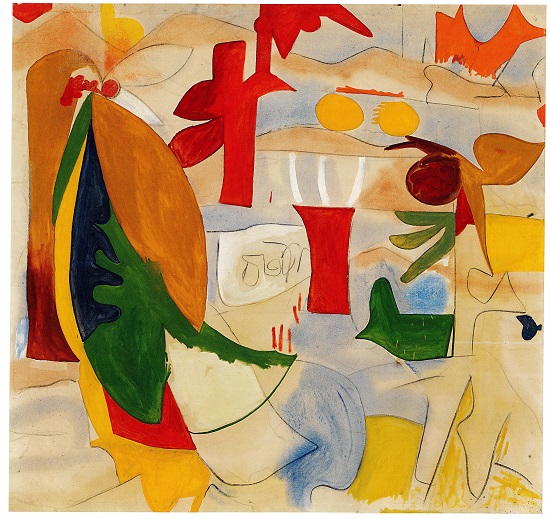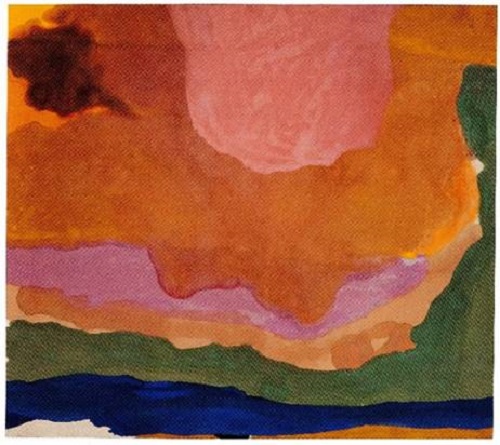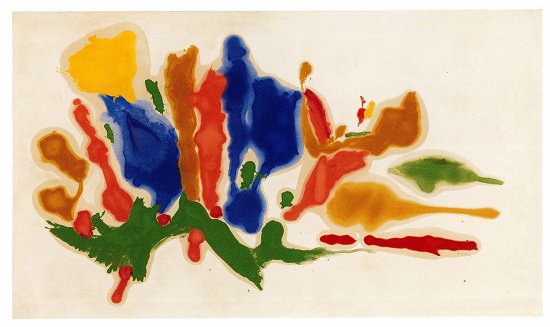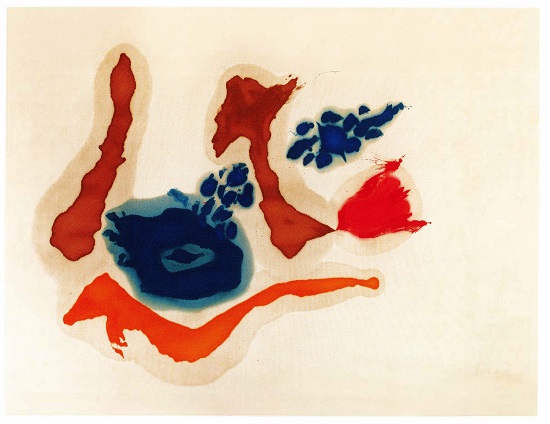"Abstract Climates: Helen Frankenthaler in Provincetown" at the Parrish Art Museum explores the impact of Provincetown and its context of water and weather on Frankenthaler's initial development. These color-infused atmospheres came to permeate the consciousness of Frankenthaler and are a persistent reference throughout all the paintings in the exhibition.
"Abstract Climates" is the first museum exhibition to focus on this aspect of the artist, which was initially presented at the Provincetown Art Association and Museum in 2018. The exhibition title comes from Frankenthaler's remark: "My pictures are full of climates, abstract climates and not nature per se, but a feeling." (1)
Like The Hamptons, Provincetown is at the eastern extremity of a narrow land mass jutting into the Atlantic (Cape Cod) and is all but surrounded by water. As with Montauk, "the end," one can go no further. Provincetown's shore is marked by sandy beaches, dunes and scattered scrubby pine forests under an expansive sky and vast waterfront horizons.
The works on view are derived from Frankenthaler's perceptions of Provincetown’s vast skies, sun drenched beaches, bright light glancing across the ocean, or subtle mists cloaking the inland pine forest. Her connections with the colors of the landscape all are evident in each and every painting shown. The artists palette can virtually be matched point for point with these references.
"Abstract Climates: Helen Frankenthaler in Provincetown" at the Parrish begins in a gallery entitled "The 1950s," when Frankenthaler, then 21 years old and fresh out of Bennington, arrived in Provincetown after Clement Greenberg (the critic who discovered Jackson Pollock) suggested she study with Hans Hofmann.
Frankenthaler's earlier works include Provincetown Bay, 1950, a semi-abstract portrayal of beachfront sand, sky, and tide that gives more than a hint of her later preoccupations. Its muted grayish hues, and thick brushy paint, however, are the antithesis of the thinly applied, luminous color she became known for.
.

Helen Frankenthaler (American, 1928–2011), Provincetown Bay, 1950. Oil on canvas, 16 ½ x 20 inches. Portland Art Museum, Oregon. © 2019 Helen Frankenthaler Foundation, Inc. / Artists Rights Society (ARS), New York. Photograph courtesy Portland Museum of Art, The Clement Greenberg Collection, Portland, OR. Courtesy Parrish Art Museum.
.
Abstract Landscape, 1951, is a Matissean composition of sinuous leaves, colorful ovoids that suggest fruit, and blue-tinted mountains outlined in charcoal. Contrasts of pale thinly applied hues with stronger fauve colors, and areas of unpainted raw canvas, anticipate features of her later manner.
.

Helen Frankenthaler (American, 1928–2011), "Abstract Landscape," 1951. Oil and charcoal on sized, primed canvas, 69 x 71 7/8 inches. Collection Helen Frankenthaler Foundation, New York. © 2019 Helen Frankenthaler Foundation, Inc. / Artists Rights Society (ARS), New York. Photograph by Rob McKeever, courtesy Gagosian Gallery and Parrish Art Museum.
.
In 1959, she returned to Provincetown with her new husband Robert Motherwell, for the first time since studying with Hans Hofmann at the beginning of the decade. The next gallery, titled "Summer of 1961," shows works painted in their Provincetown studio at Days Lumberyard.
Here, large paintings in bright prismatic color include gesturally outlined rectangles and circles in black, as in Over the Circle, 1961. While the translucent character of paint stained directly into raw canvas is evident in all of these works, figure-ground elements stand out as articulated forms surrounded by the airy unstained space around them.
.

Helen Frankenthaler (American, 1928–2011), "Over the Circle," 1961. Oil on canvas, 84 1/8 x 87 inches. Blanton Museum of Art, The University of Texas at Austin. Gift of Mari and James A. Michener, 1991. © 2019 Helen Frankenthaler Foundation, Inc. / Artists Rights Society (ARS), New York. Photograph courtesy Blanton Museum of Art, The University of Texas at Austin and Parrish Art Museum.
.
Frankenthaler favored The Hamptons early in her career, with visits to Jackson Pollock and Lee Krasner's place in East Hampton, NY. Following her marriage to Robert Motherwell in 1958, Frankenthaler's focus turned to Provincetown. While there are no artworks in the show from The Hamptons, the relationships she found within the area's artists—especially Pollock—add context and layers to the show as presented among the string of communities where these stellar artists lived, worked and played.
Frankenthaler's biography is conveyed in the exhibition through a fascinating display of archival materials selected by the exhibition's co-curators, Lise Motherwell, daughter of Robert Motherwell (brought up by Frankenthaler as step-mother) and Elizabeth A.T. Smith, Executive Director of the Helen Frankenthaler Foundation. Vintage photographs show Frankenthaler with the likes of Frank O'Hara, Clement Greenberg, Jackson Pollock, Lee Krasner, Joan Mitchell, Henry Geldzahler, and the Motherwell daughters.
There is a letter from Hans Hoffman advising about a studio (Day's Lumberyard) with descriptive sketches. We see Frankenthaler glamorously photographed by Gordon Parks for the famed 1957 Life Magazine article, "Women Artists in Ascendance: Young Group Reflects Lively Virtues of U.S. Painting," along with her contemporaries Joan Mitchell, Grace Hartigan, Jane Freilicher and Jane Wilson. Also shown, are the artists' journals with the menus, and guest lists for dinner parties.
On my second visit to the exhibition, my eye was caught by the stunning face and elegant demeanor of Helen Frankenthaler on the video which introduces the exhibition. The artist's voice projected in slow careful cadences, the tone a bit deep, every word articulated and spaced by thoughtful pauses; there was nothing scripted, but what sounded beautifully composed and carefully edited was spoken directly and naturally. Her paintings are just like that, fully formed, and perfectly shaped, though seemingly spontaneous.
In the video, reflecting on the origins of her soak stain method, Frankenthaler described the 1950 Pollock exhibition at Betty Parsons which sparked her breakthrough. His practice of painting with unprimed canvas rolled out flat on the floor, propelling enamel paints from above into trails of drips and splatters, and cropping the results, gave Frankenthaler her impetus.
The video shows Frankenthaler working with a square sponge, its lower half saturated with paint. Next, we see her hand holding a rag saturated with paint, and as she squeezes it, the paint dribbles into a flowing line on the raw canvas which she further spreads into a wavy border. Subsequently, she pours puddles of thicker paint from cans onto an area tinted with diluted color, now dry. Using an array of unconventional implements, she resolves the pigments into definite shapes.
We can see the artist's excitement as quick thinking, studio practice, and her painter's intuition combine to determine the next step. The resulting improvisations from this soak stain method became her breakthrough style, Color Field, a defining aspect of second generation Abstract Expressionism rooted in the surrealist idea of automatism.
In the exhibition's later paintings, concentrated in the final gallery, imagery fuses into a consolidated whole. The biggest of these works, Flood, 1967, owned by The Whitney, dates from the time Helen Frankenthaler moved to her fourth studio in Provincetown, a place called Nelson's Riding Stables in the woods beyond the village downtown. She went there to get a space of her own, as her prior studios in Provincetown were under the same roof as Motherwell.
Flood has a span of deep ultramarine at the bottom indicating a body of water, and undulating green areas suggest mountains. Pools of sienna, pink, and rich autumnal hues became a type of sky. Perhaps this palette reflects her studio location, now amidst the inland scrub pines. If weather is a factor, the atmosphere here is cool, damp, and misty. As a landscape merging with abstraction, the topographic reference is thoroughly consistent with events evident in the paint.
.

Helen Frankenthaler (American, 1928–2011), "Flood," 1967. Acrylic on canvas, 124 ¼ x 140 ½ inches. Whitney Museum of American Art, New York. Purchase with funds from the Friends of the Whitney Museum of American Art 68.12. © 2019 Helen Frankenthaler Foundation, Inc. / Artists Rights Society (ARS), New York. Photograph courtesy Whitney Museum of American Art, New York, and the Parrish Art Museum.
.
This gallery is energized by the contrast of earlier works done in a prior studio, Sea Barn (built by Motherwell on 37 feet of bay front), Cool Summer, 1962, is marked by the juxtaposition of jaunty abstract shapes in bright opaque colors to the neutral background.
.

Helen Frankenthaler (American, 1928–2011), "Cool Summer," 1962. Oil on canvas, 69 ¾ x 120 inches. Collection Helen Frankenthaler Foundation, New York. © 2019 Helen Frankenthaler Foundation, Inc. / Artists Rights Society (ARS), New York. Photograph by Rob McKeever, courtesy Gagosian Gallery and Parrish Art Museum.
.
Another painting, The Cape, 1962, captures the region's sea and sky in just the right tints of blue, with sand and sun perfectly matched by an intense yellow-orange. Abstract configurations that look like the narrow outstretched arm and elbow of the Cape as viewed on a map are broken into separate island shapes, with unprimed canvas around them..
.

Helen Frankenthaler (American, 1928–2011), "The Cape," 1962. Oil on canvas, 53 x 69 ¾ inches. Collection of Clifford Ross. © 2019 Helen Frankenthaler Foundation, Inc. / Artists Rights Society (ARS), New York. Photograph by Tim Pyle, Light Blue Studio, courtesy Helen Frankenthaler Foundation, New York, and Parrish Art Museum.
.
These paintings look fabulous in the vast, studio-like space of the Parrish, and feel natural in a setting punctuated by natural light and vistas to the outdoors. In contrast to our contemporary redefinition of art as market commodity or political weapon, Helen Frankenthaler (1928-2011) stands apart. In the past, there were troubles of all sorts, but the best painters created a world of their own. That of Helen Frankenthaler is one I'd enjoy living in.
____________________________
BASIC FACTS: "Abstract Climates: Helen Frankenthaler in Provincetown" is on view August 4 to October 27, 2019 at the Parrish Art Museum, 279 Montauk Highway, Water Mill, NY 11976. www.parrishart.org.
____________________________
(1) - Artist quoted in video by Perry Miller Adato "Frankenthaler: Towards a New Climate" 1978 from "The Originals: Women in Art" WNET/Ch 13 , cited in catalogue essay "East End Light" by Elizabeth A.T. Smith.
____________________________
Copyright 2019 Hamptons Art Hub LLC. All rights reserved.
